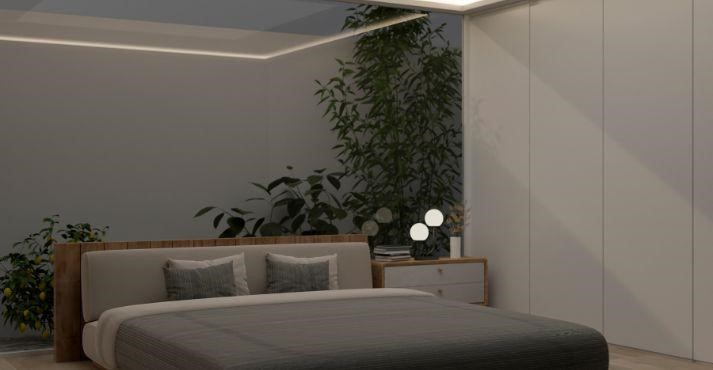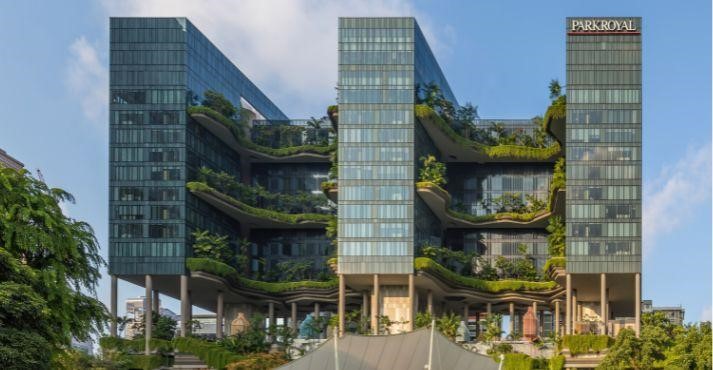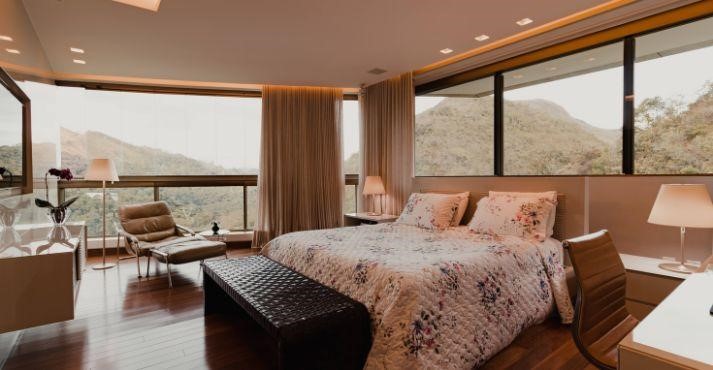Biophilic design is an architectural approach that seeks to create environments that mimic the natural world, encouraging a connection to nature within built spaces.
It’s not just about adding a few plants or creating a green wall; it involves a holistic design philosophy prioritizing human health, well-being, and environmental sustainability.
In the 1980s, biologist E.O. Wilson coined the term “biophilia,” from which this design concept derives, to describe the inherent human affinity for nature.
To truly understand biophilic design, we need to know that, given that modern humans spend up to 90% of their time indoors, it addresses the need to reconnect with natural elements meaningfully.
This reconnection has been shown to reduce stress, improve productivity, and even increase creativity.
According to a study published in the International Journal of Environmental Research and Public Health, exposure to nature can reduce stress levels by up to 40%.
In a hotel setting, biophilic design can elevate guest satisfaction and create a more positive work environment for staff.
This translates into better customer experiences, higher return rates, and a heightened brand reputation for hotels and other hospitality businesses.
Understanding Biophilic Elements
Biophilic design architecture includes various elements designed to evoke the natural world uniquely. These elements can be categorized into three broad areas: direct nature, indirect nature, and creating a sense of space and place.
Let’s explore each in depth to understand how they contribute to biophilic design in a hotel.
Direct Nature
Direct nature involves the use of tangible elements that bring the outdoors indoors. Here are some examples of direct nature in architecture and interior design:
- Natural Light: Utilizing skylights, large windows, and strategic room positioning allows for abundant natural light. This not only reduces energy costs but also creates a more welcoming atmosphere. According to the International Energy Agency, natural light can reduce energy consumption in buildings by up to 19%.
- Vegetation: Integrating indoor plants, vertical gardens, and even rooftop gardens establishes a solid connection to nature. A study by NASA demonstrated that indoor plants could remove up to 87% of toxins from the air within 24 hours. This improvement in air quality can lead to a healthier environment for guests and staff.
- Water Features: Introducing water elements like fountains, reflecting pools, or calming water sounds can create a soothing atmosphere. The presence of water has been shown to reduce stress and promote relaxation, making it an ideal addition to hotel lobbies, spas, and outdoor areas.
Indirect Nature

While direct nature focuses on physical elements, indirect nature evokes the feeling of being in nature without direct contact. This can be achieved through a variety of techniques, including biophilic design elements:
- Natural Materials: Wood, stone, bamboo, and other natural materials used in furniture, flooring, and decor add warmth and texture to spaces. These materials are often sustainably sourced, contributing to the hospitality industry’s sustainability goals. Wood and stone, in particular, have a calming effect and can significantly boost a space’s aesthetics.
- Nature-Inspired Patterns and Colors: Employing organic shapes, natural color palettes (greens, blues, and browns), and textures indicative of nature can transform a space. This approach adds a sense of calm and familiarity, creating a more relaxed atmosphere for hotel guests.
- Sensory Elements: Incorporating natural scents, calming sounds like birdsong, and optimizing air quality creates a multi-sensory experience that enhances the overall ambiance. These sensory elements can profoundly impact mood and stress, creating a more inviting environment.
Space and Place
Biophilia in architecture also focuses on creating a sense of space and place. This involves various elements that make a space feel unique and connected to the environment:
- Views of Nature: Maximizing scenic outdoor views from guest rooms and communal areas is critical to biophilic design in the hospitality industry. Research by Terrapin Bright Green found that hotel rooms with views of nature often command higher rates, indicating the premium placed on a connection to the outdoors.
- Biomimicry: Drawing inspiration from natural forms, such as the curvature of leaves or branches, adds an organic feel to architectural design elements. Projects that use curved structures, organic patterns, and other natural shapes demonstrate this.
- Connection to Local Environment: Biophilic design elements must incorporate elements that reflect a region’s unique flora and fauna. In places like Singapore, architects integrate local plant species and natural elements into their designs, fostering a sense of place and connection to the surrounding environment.
Benefits of Biophilic Design in Hotels
The benefits of biophilic design in the hospitality industry are extensive, ranging from improved guest satisfaction to increased hotel operational productivity and a better brand reputation. Let’s explore the specific advantages of biophilic hotels:
- Improved Guest Satisfaction: Guests in biophilic environments often report higher satisfaction with their experiences. A survey conducted by Terrapin Bright Green found that 90% of respondents reported increased satisfaction in biophilic spaces. This can increase repeat business, positive reviews, and stronger customer loyalty.
- Increased Productivity: Employees working in biophilic environments report higher job satisfaction and productivity levels. The calming effects of biophilic design contribute to a more positive work environment, leading to improved customer service and lower staff turnover rates.
- Enhanced Brand Reputation: Hotels that adopt biophilic design are often seen as environmentally conscious and forward-thinking. This perception can attract hotel guests who value sustainability and prefer establishments that align with their values. Biophilic design can become a significant differentiator in a competitive market as the demand for eco-friendly hotels grows.
Examples of Biophilic Design in Hotels

Several hotels in Singapore and Southeast Asia have successfully implemented biophilic design elements. These establishments serve as excellent examples of what biophilic design is and how biophilic design can be incorporated into hospitality spaces:
- Oasia Hotel Downtown: The Oasia hotel is a striking example of biophilic design in Singapore. The building’s exterior is covered in a red aluminum mesh shrouded in various plant species, creating a unique and visually stunning facade. The hotel’s design features large communal areas filled with greenery and natural light, contributing to its biophilic charm.
- PARKROYAL on Pickering: Another Singapore-based hotel that incorporates biophilic design, PARKROYAL on Pickering features over 15,000 square meters of lush gardens and verdant terraces. This hotel’s innovative design earned it the World Travel Award for “World’s Leading Green City Hotel” in 2018 and a spot on Forbes’ “Hotel of the Future” list.
- Westin Buffalo: This hotel in Buffalo, New York, integrates several biophilic elements, including a living wall, indoor plants, and abundant natural light. These features create a connection to nature and contribute to a positive guest experience.
Implementing Biophilic Design in Your Hotel
To implement the biophilic design in a hotel, it’s essential to consider different areas and understand how biophilic elements can be integrated to create a cohesive and inviting environment. Here’s a closer look at how to incorporate biophilic design across various hotel sections:
Considerations for Different Hotel Areas
- Lobbies and Reception: The lobby is often the first point of contact for guests, making it crucial to create a welcoming atmosphere. Consider lobby design ideas like abundant natural light, greenery through potted plants or living walls, and calming water features like fountains or reflecting pools. This combination sets a positive tone for the entire hotel.
- Guest Rooms: Guest rooms should be designed to promote relaxation and comfort. Integrate natural light by maximizing window space and using light-reflecting surfaces. Include potted plants for a touch of greenery, and use nature-inspired decor to create a serene environment. Offering rooms with scenic views is one of the most effective hotel room design ideas that improve guest satisfaction.
- Restaurants and Bars: Natural materials such as wood and stone can improve the dining experience. Add large windows or outdoor seating areas to incorporate scenic views. A vertical garden or minor water feature can further elevate the ambiance, creating a unique dining experience that guests will remember.
- Spa and Wellness Areas: Spas and wellness areas should promote relaxation and rejuvenation. Incorporate water features, natural textures, and lush plant life to create a calming atmosphere. These elements can contribute to tranquility and encourage guests to unwind.
Budget-Friendly Biophilic Design

While some biophilic design elements may require significant investment, there are budget-friendly strategies that allow hotels to embrace biophilic design without breaking the bank:
- Strategic Use of Houseplants: Houseplants are a cost-effective way to introduce biophilic design elements. Consider low-maintenance plants in critical areas like lobbies, corridors, and guest rooms. Plants like succulents, snake plants, and peace lilies are ideal for indoor environments and can thrive with minimal care.
- Natural Lighting Strategies: Maximize existing window space and use light-reflecting surfaces to increase natural light. This approach reduces energy costs and creates a brighter, more inviting environment. Consider using mirrors strategically to reflect and distribute natural light throughout space.
- Nature-Inspired Artwork and Murals: Nature-inspired artwork and murals can create a connection to nature without significant structural changes. Artwork depicting landscapes or murals featuring organic shapes and patterns can transform a space, creating calm and tranquility.
Enhancing the Guest Experience with Biophilic Design
Implementing biophilic design in a hotel setting can significantly enhance the guest experience. By focusing on the key elements of direct nature, indirect nature, and space and place, hotels can create visually stunning and emotionally engaging environments.
Consider incorporating elements encouraging guests to interact with their surroundings, such as outdoor spaces for relaxation, walking trails, or guided nature tours.
These activities create lasting memories and encourage guests to return. Moreover, promoting sustainable practices, such as recycling programs, water conservation, and energy-efficient lighting, can further boost the hotel’s biophilic appeal and attract environmentally conscious travelers.
Staff Productivity and Satisfaction
Biophilic design benefits guests and can also improve staff productivity and satisfaction. By incorporating natural elements into the work environment, hotels can adopt a more positive and engaging atmosphere for employees.
This leads to higher job satisfaction, reduced stress, and increased productivity. Consider providing outdoor break areas or indoor spaces with abundant natural light and greenery, offering employees a refreshing escape from their daily tasks.
Conclusion
Biophilic design transforms the hospitality industry by bringing nature into the built environment. The benefits are clear: improved guest satisfaction, increased productivity, and increased brand reputation.
By adopting biophilic design, hotels can create environments that resonate with guests and promote well-being.
By truly understanding what is biophilic design and its strategies, hotels can stand out in a competitive market and provide guests with an unforgettable experience that keeps them coming back.
Whether incorporating direct elements of nature, creating a sense of space and place, or exploring budget-friendly options, biophilic design offers something for every hospitality space.















